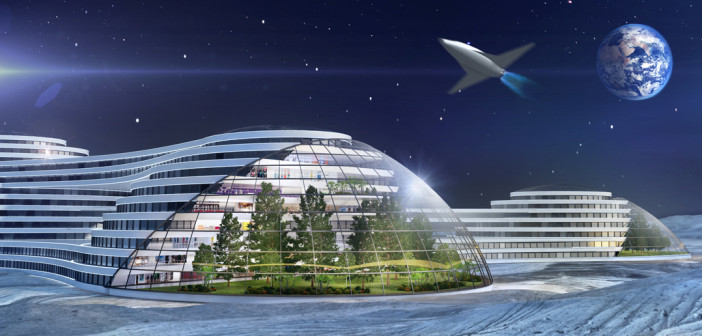Three day working week will be a real possibility as we work smarter and attend meetings remotely via holograms
Super skyscrapers that will dwarf London’s Shard building, underwater bubble cities and hyper-flexible living spaces are all likely to be reality in 100 years’ time. That’s the verdict of a new study that paints a vivid picture of our future lives, suggesting the way we live, work and play will change beyond all recognition over the course of the next century.
The SmartThings Future Living Report, sponsored by Samsung’s SmartThings, a system that allows people to make their home smarter, was authored by a team of leading academics including TV presenter and one of the UK’s leading space scientists, Dr Maggie Aderin-Pocock, award-winning futurist architects and lecturers at the University of Westminster, Arthur Mamou-Mani and Toby Burgess, as well as pioneering urbanists Linda Aitken and Els Leclerq.
On top of looking at how we will live in 100 years’ time, SmartThings surveyed 2,000 British adults to pinpoint the predictions the nation thought were most likely to become a reality in the future.
Many of the predictions were influenced by environmental conditions, with growing populations leading to the development of structures that are better able to cope with space constraints and diminishing resources.
As city space becomes more squeezed, we will burrow deeper and build higher with the creation of super skyscrapers, using carbon nanotubes and diamond nanothreads, which will help us create towering megastructures that will dwarf today’s skyscrapers, according to 18% of those surveyed.
There may also be Earth-scrapers; just as we build up, we will also dig down with huge structures that will tunnel 25 storeys deep or more, said 16% of those questioned. Also underwater cities are likely to become a reality, using the water itself to create breathable atmospheres and generating hydrogen fuel through the process.
Personal flying drones will replace cars and travelling holiday homes. Some of us will be travelling skyways with our own personal flying drones instead of using cars, with ‘drone mules’ strong enough to carry entire homes around the world for holidays, for a true ‘home away from home’ holiday experience.
As technology develops, we’ll see 3D printing of houses and furniture, said 25% of respondents to the survey; we will be able to print exact replicas of large scale structures like houses out of local, recyclable materials. There will be hyper-flexible living spaces and smart walls. Flexible living spaces will adapt to our needs by changing room layouts and furniture, as moving partitions make a bedroom smaller and living room larger when receiving guests, or malleable walls provide extra seats or shelving on demand. Also, smart LED room surfaces will mean you won’t need to re-decorate your home, as walls, floors and ceilings will adapt to suit your mood, according to 26% of survey respondents.
Virtual meetings and a three day working week will come to pass with 48% of respondents to the survey stating this is the number one prediction for future living; our working lives will be transformed with the use of holograms that will allow us to attend meetings virtually, enabling us to interact truly as though in the same room as colleagues without needing to leave the comfort of our homes. Time saved travelling to and attending meetings could lead to a shorter working week thanks to improved time efficiency.
A further 18% of those questioned reckon that artificial intelligence will become a normal part of daily life, taking over from humans in many industries.
Also, stepping into home medi-pods will confirm if you really are ill, providing a digital diagnosis and supplying medicine or a remote surgeon if needed, meaning ‘pulling a sickie’ could be a thing of the past, said 24% of those questioned.
And finally, we will colonise space; first the Moon, then Mars and then far beyond into the galaxy. Altogether, 41% of those surveyed believe we will have commercial flights into space.
Space scientist Aderin-Pocock, who co-authored the report, commented: “Our lives today are almost unrecognisable from those a century ago. The internet has revolutionised the way we communicate, learn and control our lives. Just ten years ago, technology like SmartThings would have been inconceivable, yet today, developments like this let us monitor, control and secure our living spaces with the touch of a smartphone. Over the next century we will witness further seismic shifts in the way we live and interact with our surroundings; working on The SmartThings Future Living Report with a panel of industry experts, has allowed me to explore what these could be.
James Monighan, UK MD at Samsung SmartThings, which commissioned the report, added: “The smart home revolution will have massively positive implications on how we live. Our homes are becoming smarter and can now detect the presence of things like people, pets, smoke, humidity, lighting, and moisture. And this is just the beginning.
“Just as the technology driving the internet has spread to smartphones and smart homes, the smart home revolution is destined to spread to larger communities and countries,” continued Monighan. “By simply turning lights and heating off when we don’t use them, we can reduce emissions. By being able to better monitor and secure our homes, we can reduce crime. By better monitoring the habits of aging relatives, we help them to achieve greater independence and a higher quality of life.”
The report has been published to coincide with the announcement that from the start of 2016, SmartThings will work with hundreds of products from a wide range of brands, as well as working with all of Samsung’s TVs, refrigerators, washing machines, ovens and robot vacuum cleaners.





